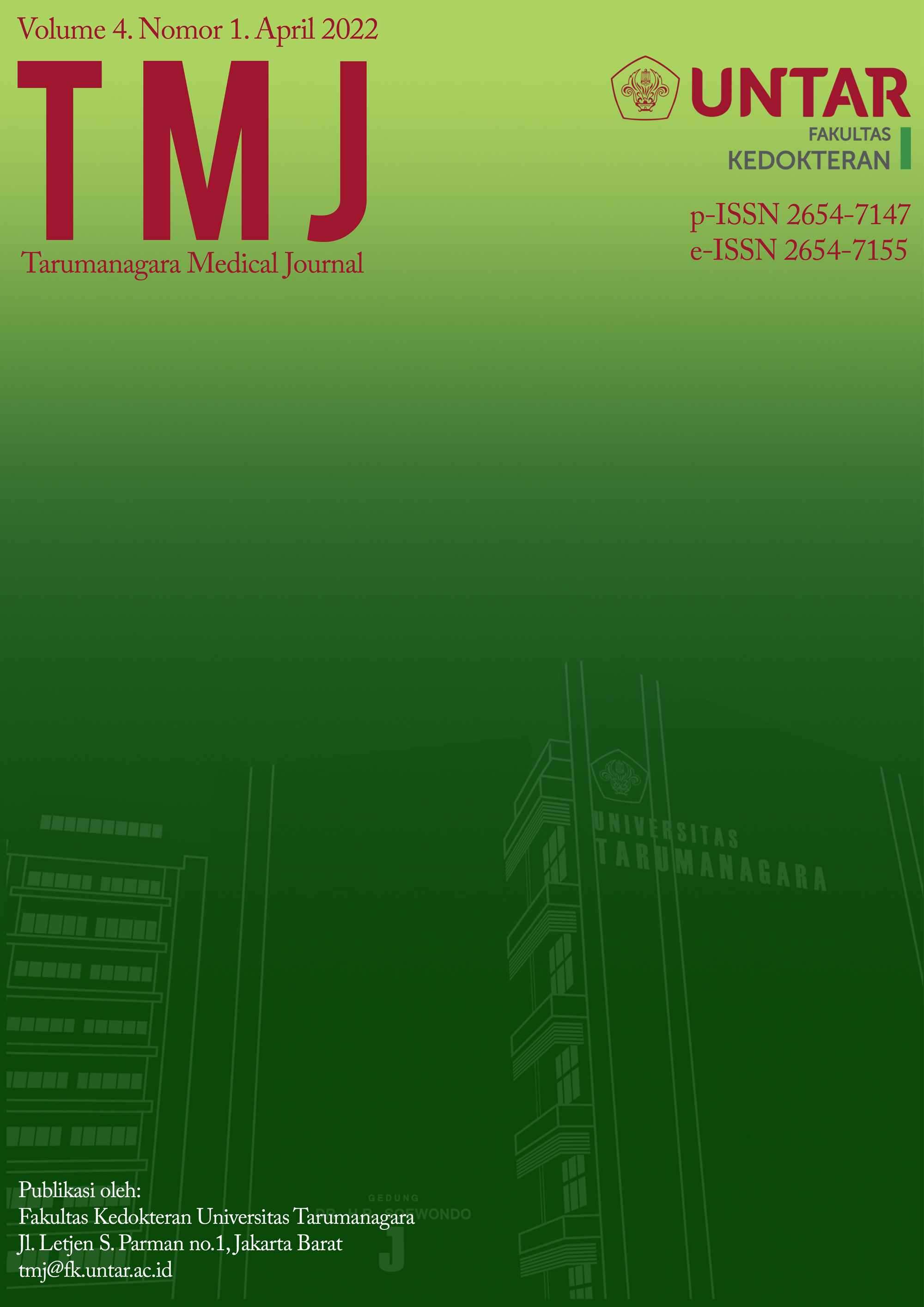Analisis cross reactivity protein precursor membrane (prM) virus dengue endemik Indonesia dengan pendekatan imunoinformatik
Main Article Content
Abstract
Infeksi demam berdarah dianggap sebagai salah satu masalah kesehatan utama di Indonesia dan disebabkan oleh virus dengue. Kemampuan reaksi silang pada virus dengue dapat memperparah jika terjadi infeksi lainnya. Protein precursor membrane (prM) pada virus dengue merupakan bagian yang rentan akan terjadinya antibody dependant enhancement dan evolusi gen prM berubah setiap tahunnya. Studi ini bertujuan untuk menganalisa reaksi silang gen prM dari virus dengue yang endemis di Indonesia. Sebanyak 96 data sampel dari National Center for Biotechnology Information digunakan pada studi ini. Prediksi antigenisitas dengan metode B-cell epitope prediction lalu di lanjutkan proses analisis reaksi silang menggunakan Basic Local Aligntment Search Tool (BLAST) dengan perbagian 20 protein prM pada setiap genotype virus yang memiliki antigenisitas yang spesifitasnya 0,8. Hasil dari studi ini didapatkan 4 prediksi antigenisitas dan beberapa hasil reaksi silang terhadap protein lain seperti anti-SARS-CoV-2 immunoglobulin heavy chain, human immunodeficiency virus type I enhancer-binding protein 2, insulin receptor substrate like protein partial, cerebellar-degeneration-related antigen. Pada studi ini ditemukan adanya perubahan prediksi antigenisitas dari gen prM virus dengue yang muncul setiap tahun dan adanya reaksi silang dengan protein lain.
Article Details

This work is licensed under a Creative Commons Attribution-NonCommercial-ShareAlike 4.0 International License.
Penulis yang menerbitkan artikelnya di Tarumanagara Medical Journal (TMJ) setuju dengan ketentuan sebagai berikut:
- Penulis mempertahankan hak cipta dan memberikan jurnal hak publikasi pertama dengan bekerja secara bersamaan dilisensikan di bawah Creative Commons Attribution yang memungkinkan orang lain untuk berbagi karya dengan pengakuan atas kepengarangan dari karya asli dan publikasi dalam jurnal ini.
- Penulis dapat masuk ke dalam pengaturan kontrak tambahan yang terpisah untuk distribusi non-eksklusif jurnal versi pekerjaan yang dipublikasikan (misalnya, memposting ke repositori institusional atau menerbitkannya dalam buku), dengan pengakuan publikasi awal dalam jurnal ini.
- Setiap teks yang dikirim harus disertai dengan "Perjanjian Transfer Hak Cipta" yang dapat diunduh melalui tautan berikut: Unduh
References
Raveendran S. Dengue Syok Sindrom. Ilmu Anestesi Reanimasi FK UNUD. 2016.
Direktorat Jenderal Pencegahan dan Penegndalian Penyakit Kementrian Kesehatan RI. Hingga Juli, Kasus DBD di Indonesia Capai 71 Ribu. Kemenkes RI. 2020. Available from: http://p2p.kemkes.go.id/hingga-juli-kasus-dbd-di-indonesia-capai-71-ribu/
Vita R, Zarebski L, Greenbaum JA, Emami H, Hoof I, Salimi N, et al. The immune epitope database 2.0. Nucleic Acids Res. 2010;38(Database issue):D854-62.
Salimi N, Fleri W, Sette A. The immune epitope database : a historical retrospective of the first decade. Immunology.2012;117–23.
Wang S, He R, Anderson R. PrM- and Cell-Binding Domains of the Dengue Virus E Protein. J Virol. 1999;73(3):2547–51.
Harapan H, Michie A, Yohan B, Shu P-Y, Mudatsir M, Sasmono RT, et al. Dengue viruses circulating in Indonesia: A systematic review and phylogenetic analysis of data from five decades. Rev Med Virol. 2019;29(4):e2037.
Karyanti MR, Uiterwaal CSPM, Kusriastuti R, Hadinegoro SR, Rovers MM, Heesterbeek H, et al. The changing incidence of Dengue Haemorrhagic Fever in Indonesia: A 45-year registry-based analysis. BMC Infect Dis. 2014;14(1):[7p.].
Porter KR, Beckett CG, Kosasih H, Tan RI, Alisjahbana B, Rudiman PIF, et al. Epidemiology of dengue and dengue hemorrhagic fever in a cohort of adults living in Bandung, West Java, Indonesia. Am J Trop Med Hyg. 2005;72(1):60–6.
Aryati A, Trimarsanto H, Yohan B, Wardhani P, Fahri S, Sasmono RT. Performance of commercial dengue NS1 ELISA and molecular analysis of NS1 gene of dengue viruses obtained during surveillance in Indonesia. BMC Infect Dis. 2013;13:611.
Shu PY, Chien LJ, Chang SF, Su CL, Kuo YC, Liao TL, et al. Fever screening at airports and imported dengue. Emerg Infect Dis. 2005;11(3):460–2.
Kumar S, Tamura K, Nei M. MEGA3: Integrated software for Molecular Evolutionary Genetics Analysis and sequence alignment. Brief Bioinform. 2004;5(2):150–63.
Jenkins GM, Rambaut A, Pybus OG, Holmes EC. Rates of molecular evolution in RNA viruses: A quantitative phylogenetic analysis. J Mol Evol. 2002;54(2):156–65.
Ali M, Pandey RK, Khatoon N, Narula A, Mishra A, Prajapati VK. Exploring dengue genome to construct a multi-epitope based subunit vaccine by utilizing immunoinformatics approach to battle against dengue infection. Sci Rep. 2017;7(1):1–13.
Correa ARV, Berbel ACER, Papa MP, De Morais ATS, Peçanha LMT, De Arruda LB. Dengue virus directly stimulates Polyclonal B cell activation. PLoS One. 2015;10(12):1–20.
Torres MC, Martins Karl AL, Müller Pereira da Silva M, Dardenne LE, Bispo de Filippis AM. In Silico Analysis of Dengue Virus Serotype 2 Mutations Detected at the Intrahost Level in Patients with Different Clinical Outcomes. Microbiol Spectr. 2021;9(2):e00256-21.
Pollett S, Melendrez MC, Maljkovic Berry I, Duchêne S, Salje H, Cummings DAT, et al. Understanding dengue virus evolution to support epidemic surveillance and counter-measure development. Infect Genet Evol. 2018;62:279–95.
Katzelnick LC, Coello Escoto A, Huang AT, Garcia-Carreras B, Chowdhury N, Maljkovic Berry I, et al. Antigenic evolution of dengue viruses over 20 years. Science. 2021;374(6570):999–1004.
Guzman MG, Vazquez S. The complexity of antibody-dependent enhancement of dengue virus infection. Viruses. 2010;2(12):2649–62.
Masyeni S, Santoso MS, Widyaningsih PD, Asmara DW, Nainu F, Harapan H, et al. Serological cross-reaction and coinfection of dengue and COVID-19 in Asia: Experience from Indonesia. Int J Infect Dis. 2021;102:152–4.
Watt G, Kantipong P, Jongsakul K. Decrease in human immunodeficiency virus type 1 load during acute dengue fever. Clin Infect Dis. 2003;36(8):1067–9.
Ramos C, Sánchez G, Hernández Pando R, Baquera J, Hernández D, Mota J, et al. Dengue virus in the brain of a fatal case of hemorrhagic dengue fever. J Neurovirol. 1998;4(4):465–8.



